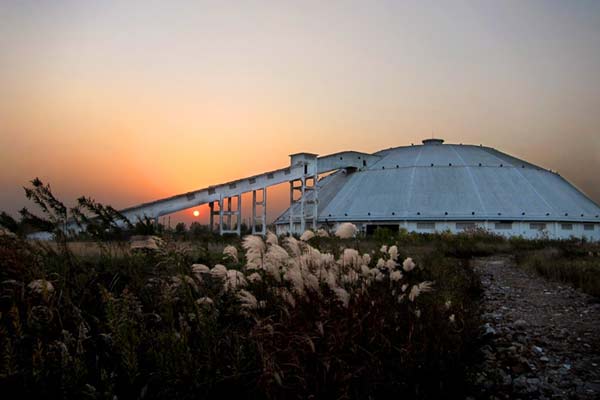
|
 |
|
This 6,000 square-meter old cement plant, seen in an early evening glow, will serve as the central space for Shanghai’s West Bund 2013: A Biennale of Architecture and Contemporary Art. |
By getting the public more involved in art in a big open way, the Shanghai West Bund Biennale brings new vitality to the city. Yang Yang reports.
Any river that runs through a great city always seems to add vitality and remove the coldness of modern high-rises made of steel, concrete, and glass, and provide some choices for the people who plan the city. Two examples that spring to mind are the Thames and the Seine.
The south bank of the Thames contains one of Europe's largest cultural districts, where British theaters attract artists and audiences from all over the world, giving London more creativity and rhythm.
The left bank of the Seine, at its peak, was enchanting and attracted the world's top artists, philosophers, novelists, and poets to come and debate and construct avant-garde theories, making Paris a mecca of art and thought at the time.
In a similar vein, in the East, there's Shanghai, whose ambition is to become a cultured cosmopolis and a center of finance, the economy, trade and shipping as well. So it's working on a public artistic space on the bund along the Huangpu River.
One of this year's most highlighted programs in the area is West Bund 2013: A Biennale of Architecture and Contemporary Art, which the city is offering the public as an outdoor space to bring more cultural vitality
It's not that Shanghai is exactly lacking in art space. It is reported to have more than 300 art museums and galleries, although that's down from more than 800 at its peak. Two examples, 50 Moganshan Road and the Hongfang Art and Culture Community, have been landmarks of Shanghai's creativity and culture for some time. And, it has the already 17-year-old Shanghai Biennale.
So what's the point of pouring more money and resources into yet another space? Or, more important: Even if the government wants to create another open art space, will the artists and public necessarily accept the good intention and enjoy themselves on the waterfront?
One answer comes from Mohsen Mostafavi, the dean of Harvard University's Graduate School of Design, who shares his observation on how to create positive interaction between the public and projects by saying simply, "The best way to attract citizens to public art space is to let them get involved in the process of planning and construction."
However, the West Bund did not make its blueprint public or seek the public's opinion, unlike, say, Hong Kong's West Kowloon Cultural District. But it does try to get their attention with various programs, for example, last year, when the government held the first West Bund Music Festival, or this year, when the event will continue to attract people.
The West Bund 2013 exhibition comes on Oct 19, alongside the Huangpu River under a gigantic gray dome, on the 6,000 square meters of a defunct cement plant. The 58-day biennale marks the beginning of a new life for the former industrial site and possibly many others as well.
The old cement plant will be converted into what is called a "cloud theater" — a new theater style that combines different artistic forms, such as film, music, architecture and literature.
